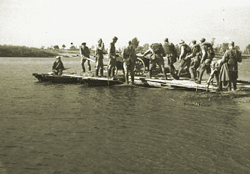Battle of the Dnieper
| Lower Dnieper Offensive | |||||||||
|---|---|---|---|---|---|---|---|---|---|
| Part of the Eastern Front of World War II | |||||||||
 Soviet soldiers crossing the Dnieper on improvised rafts |
|||||||||
|
|||||||||
| Belligerents | |||||||||
|
|
|
||||||||
| Commanders and leaders | |||||||||
|
|
|
||||||||
| Strength | |||||||||
|
Initially 2,650,000 men 51,000 guns 2,400 tanks 2,850 aircraft |
Initially 1,250,000 men 12,600 guns 2,100 tanks 2,000 aircraft |
||||||||
| Casualties and losses | |||||||||
| Varied, from ~1,200,000 to 1,500,000 Krivosheev: 1,286,000 total casualties 348,815 dead 937,162 wounded or sick David M. Glantz: 1,182,000 total casualties 276,000 dead 906,000 wounded or sick Nikolai Shefov: 1,500,000 total casualties 373,000 killed |
Varied greatly, from ~400,000+ to 1,500,000 (see text) | ||||||||
The Battle of the Dnieper was a military campaign that took place in 1943 on the Eastern Front of World War II. It was one of the largest operations in World War II, involving almost 4,000,000 troops on both sides and stretching on a 1,400 kilometres (870 mi) long front. During its four-month duration, the eastern bank of the Dnieper was recovered from German forces by five of the Red Army's fronts, which conducted several assault river crossings to establish several lodgements on the western bank. Subsequently, Kiev was liberated in the Battle of Kiev.
One of the costliest operations of the war, the casualties are estimated at being from 1,700,000 to 2,700,000 on both sides. One of the most tragic events took place during the establishment of so-called Bukryn lodgement near the village of Malyi Bukryn (Myronivka Raion). The Soviet writer and war veteran Viktor Astafyev in his memoirs was recalling that 25,000 soldiers who entered the Dnieper from one side, would exit the river on the other side in amounts of 5-6,000. Due to heavy losses, STAVKA theorists came under pressure from both above and below to modify broad-front advances with the more concentrated blow of Deep operations, and the Dnieper Airborne Assault became the last mass airborne operation used by the Soviet Union during World War II.
2,438 soldiers were awarded the Hero of the Soviet Union which was more than had been awarded previously since the award's establishment and never again was there such a large number of laureates.
Following the Battle of Kursk, the Wehrmacht's Heer and supporting Luftwaffe forces in the southern Soviet Union were on the defensive in the southern Ukraine. By mid-August, Adolf Hitler understood that the forthcoming Soviet offensive could not be contained on the open steppe and ordered construction of a series of fortifications along the line of the Dnieper river.
...
Wikipedia
